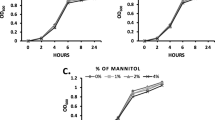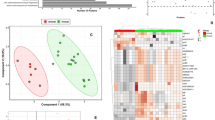Abstract
Streptococcus agalactiae is a major neonatal pathogen that is able to colonise various host environments and is associated with both gastrointestinal and vaginal maternal carriage. Maternal vaginal carriage represents the major source for transmission of S. agalactiae to the foetus/neonate and thus is a significant risk factor for neonatal disease. In order to understand factors influencing maternal carriage we have investigated growth and long term survival of S. agalactiae under conditions of low pH and nutrient stress in vitro. Surprisingly, given that vaginal pH is normally <4.5, S. agalactiae was found to survive poorly at low pH and failed to grow at pH 4.3. However, biofilm growth, although also reduced at low pH, was shown to enhance survival of S. agalactiae. Proteomic analysis identified 26 proteins that were more abundant under nutrient stress conditions (extended stationary phase), including a RelE family protein, a universal stress protein family member and four proteins that belong to the Gls24 (PF03780) stress protein family. Cumulatively, these data indicate that novel mechanisms are likely to operate that allow S. agalactiae survival at low pH and under nutrient stress during maternal vaginal colonisation and/or that the bacteria may access a more favourable microenvironment at the vaginal mucosa. As current in vitro models for S. agalactiae growth appear unsatisfactory, novel methods need to be developed to study streptococcal colonisation under physiologically-relevant conditions.

Similar content being viewed by others
References
Barcaite E, Bartusevicius A, Tameliene R, Kliucinskas M, Maleckiene L, Nadisauskiene R (2008) Prevalence of maternal group B streptococcal colonisation in European countries. Acta Obstet Gynecol Scand 87:260–271
Borges S, Silva J, Teixeira P (2012) Survival and biofilm formation by group B streptococci in simulated vaginal fluid at different pHs. Antonie van Leeuwenhoek 101:677–682
Busuioc M, Buttaro BA, Piggot PJ (2010) The pdh operon is expressed in a subpopulation of stationary-phase bacteria and is important for survival of sugar-starved Streptococcus mutans. J Bacteriol 192:4395–4402
Colbourn T, Gilbert R (2007) An overview of the natural history of early onset group B streptococcal disease in the UK. Early Hum Dev 83:149–156
Domingue PA, Sadhu K, Costerton JW, Bartlett K, Chow AW (1991) The human vagina: normal flora considered as an in situ tissue-associated, adherent biofilm. Genitourin Med 67:226–231
Edmond KM, Kortsalioudaki C, Scott S, Schrag SJ, Zaidi AK, Cousens S, Heath PT (2012) Group B streptococcal disease in infants aged younger than 3 months: systematic review and meta-analysis. Lancet 379:547–556
El Aila NA, Tency I, Claeys G, Saerens B, De Backer E, Temmerman M, Verhelst R, Vaneechoutte M (2009) Genotyping of Streptococcus agalactiae (group B streptococci) isolated from vaginal and rectal swabs of women at 35–37 weeks of pregnancy. BMC Infect Dis 9:153
Ferrieri P, Hillier SL, Krohn MA, Moore D, Paoletti LC, Flores AE (2004) Characterization of vaginal & rectal colonization with multiple serotypes of group B streptococci using multiple colony picks. Indian J Med Res 119(Suppl):208–212
Finkel SE (2006) Long-term survival during stationary phase: evolution and the GASP phenotype. Nat Rev Microbiol 4:113–120
Gerdes K, Christensen SK, Løbner-Olesen A (2005) Prokaryotic toxin-antitoxin stress response loci. Nat Rev Microbiol 3:371–382
Giard JC, Rince A, Capiaux H, Auffray Y, Hartke A (2000) Inactivation of the stress- and starvation-inducible gls24 operon has a pleiotropic effect on cell morphology, stress sensitivity, and gene expression in Enterococcus faecalis. J Bacteriol 182:4512–4520
Giard JC, Verneuil N, Auffray Y, Hartke A (2002) Characterization of genes homologous to the general stress-inducible gene gls24 in Enterococcus faecalis and Lactococcus lactis. FEMS Microbiol Lett 206:235–239
Goodman JR, Berg RL, Gribble RK, Meier PR, Fee SC, Mitchell PD (1997) Longitudinal study of group B Streptococcus carriage in pregnancy. Infect Dis Obstet Gynecol 5:237–243
Håkansson S, Axemo P, Bremme K, Bryngelsson A-L, Wallin MC, Ekström C-M, Granlund M, Jacobsson B, Källén E, Tessin I, Swedish Working Group for the Prevention of Perinatal Group B Streptococcal Infections (2008) Group B streptococcal carriage in Sweden: a national study on risk factors for mother and infant colonisation. Acta Obstet Gynecol Scand 87:50–58
Hall-Stoodley L, Stoodley P (2009) Evolving concepts in biofilm infections. Cell Microbiol 11:1034–1043
Hansen SM, Uldbjerg N, Kilian M, Sørensen UB (2004) Dynamics of Streptococcus agalactiae colonization in women during and after pregnancy and in their infants. J Clin Microbiol 42:83–89
Heath PT, Balfour G, Weisner AM, Efstratiou A, Lamagni TL, Tighe H, O’Connell LA, Cafferkey M, Verlander NQ, Nicoll A, McCartney AC, PHLS Group B Streptococcus Working Group (2004) Group B streptococcal disease in UK and Irish infants younger than 90 days. Lancet 363:292–294
Kaur H, Kumar P, Ray P, Kaur J, Chakraborti A (2009) Biofilm formation in clinical isolates of group B streptococci from north India. Microb Pathog 46:321–327
Konto-Ghiorghi Y, Mairey E, Mallet A, Duménil G, Caliot E, Trieu-Cuot P, Dramsi S (2009) Dual role for pilus in adherence to epithelial cells and biofilm formation in Streptococcus agalactiae. PLoS Pathog 5:e1000422
Kunze M, Ziegler A, Fluegge K, Hentschel R, Proempeler H, Berner R (2011) Colonization, serotypes and transmission rates of group B streptococci in pregnant women and their infants born at a single University Center in Germany. J Perinat Med 39:417–422
Kvint K, Nachin L, Diez A, Nyström T (2003) The bacterial universal stress protein: function and regulation. Curr Opin Microbiol 6:140–145
Madzivhandila M, Adrian PV, Cutland CL, Kuwanda L, Schrag SJ, Madhi SA (2011) Serotype distribution and invasive potential of group B Streptococcus isolates causing disease in infants and colonizing maternal-newborn dyads. PLoS ONE 6:e17861
Manning SD, Lewis MA, Springman AC, Lehotzky E, Whittam TS, Davies HD (2008) Genotypic diversity and serotype distribution of group B Streptococcus isolated from women before and after delivery. Clin Infect Dis 46:1829–1837
Martinez AR, Abranches J, Kajfasz JK, Lemos JA (2010) Characterization of the Streptococcus sobrinus acid-stress response by interspecies microarrays and proteomics. Mol Oral Microbiol 25:331–342
Melin P (2011) Neonatal group B streptococcal disease: from pathogenesis to preventive strategies. Clin Microbiol Infect 17:1294–1303
Nair S, Poyart C, Beretti JL, Veiga-Fernandes H, Berche P, Trieu-Cuot P (2003) Role of the Streptococcus agalactiae ClpP serine protease in heat-induced stress defence and growth arrest. Microbiology 149:407–417
Nieto C, Pellicer T, Balsa D, Christensen SK, Gerdes K, Espinosa M (2006) The chromosomal relBE2 toxin-antitoxin locus of Streptococcus pneumoniae: characterization and use of a bioluminescence resonance energy transfer assay to detect toxin-antitoxin interaction. Mol Microbiol 59:1280–1296
Nieto C, Sadowy E, de la Campa AG, Hryniewicz W, Espinosa M (2010) The relBE2Spn toxin-antitoxin system of Streptococcus pneumoniae: role in antibiotic tolerance and functional conservation in clinical isolates. PLoS ONE 5:e11289
Oliver JD (2010) Recent findings on the viable but nonculturable state in pathogenic bacteria. FEMS Microbiol Rev 34:415–425
Olson ME, Ceri H, Morck DW, Buret AG, Read RR (2002) Biofilm bacteria: formation and comparative susceptibility to antibiotics. Can J Vet Res 66:86–92
Papadimitriou K, Pratsinis H, Nebe-von-Caron G, Kletsas D, Tsakalidou E (2007) Acid tolerance of Streptococcus macedonicus as assessed by flow cytometry and single-cell sorting. Appl Environ Microbiol 73:465–476
Pérez-Ruiz M, Rodríguez-Granger JM, Bautista-Marín MF, Romero-Noguera J, Rosa-Fraile M (2004) Genetic diversity of Streptococcus agalactiae strains colonizing the same pregnant woman. Epidemiol Infect 132:375–378
Rajagopal L, Vo A, Silvestroni A, Rubens CE (2005) Regulation of purine biosynthesis by a eukaryotic-type kinase in Streptococcus agalactiae. Mol Microbiol 56:1329–1346
Rantanen MK, Lehtiö L, Rajagopal L, Rubens CE, Goldman A (2007) Structure of the Streptococcus agalactiae family II inorganic pyrophosphatase at 2.80 A resolution. Acta Crystallogr D Biol Crystallogr 63:738–743
Renye JA Jr, Piggot PJ, Daneo-Moore L, Buttaro BA (2004) Persistence of Streptococcus mutans in stationary-phase batch cultures and biofilms. Appl Environ Microbiol 70:6181–6187
Rezaïki L, Lamberet G, Derré A, Gruss A, Gaudu P (2008) Lactococcus lactis produces short-chain quinones that cross-feed group B Streptococcus to activate respiration growth. Mol Microbiol 67:947–957
Rinaudo CD, Rosini R, Galeotti CL, Berti F, Necchi F, Reguzzi V, Ghezzo C, Telford JL, Grandi G, Maione D (2010) Specific involvement of pilus type 2a in biofilm formation in group B Streptococcus. PLoS ONE 5:e9216
Stoyanov JV, Mancini S, Lu ZH, Mourlane F, Poulsen KR, Wimmer R, Solioz M (2010) The stress response protein Gls24 is induced by copper and interacts with the CopZ copper chaperone of Enterococcus hirae. FEMS Microbiol Lett 302:69–75
Tamura GS, Kuypers JM, Smith S, Raff H, Rubens CE (1994) Adherence of group B streptococci to cultured epithelial cells: roles of environmental factors and bacterial surface components. Infect Immun 62:2450–2458
Tazi A, Disson O, Bellais S, Bouaboud A, Dmytruk N, Dramsi S, Mistou MY, Khun H, Mechler C, Tardieux I, Trieu-Cuot P, Lecuit M, Poyart C (2010) The surface protein HvgA mediates group B Streptococcus hypervirulence and meningeal tropism in neonates. J Exp Med 207:2313–2322
Tettelin H, Masignani V, Cieslewicz MJ, Donati C, Medini D, Ward NL, Angiuoli SV, Crabtree J, Jones AL, Durkin AS, DeBoy RT, Davidsen TM, Mora M, Scarselli M, Ros IMY, Peterson JD, Hauser CR, Sundaram JP, Nelson WC, Madupu R, Brinkac LM, Dodson RJ, Rosovitz MJ, Sullivan SA, Daugherty SC, Haft DH, Selengut J, Gwinn ML, Zhou LW, Zafar N, Khouri H, Radune D, Dimitrov G, Watkins K, O’Connor KJB, Smith S, Utterback TR, White O, Rubens CE, Grandi G, Madoff LC, Kasper DL, Telford JL, Wessels MR, Rappuoli R, Fraser CM (2005) Genome analysis of multiple pathogenic isolates of Streptococcus agalactiae: implications for the microbial “pan-genome”. Proc Natl Acad Sci USA 102:13950–13955
Tran TD, Kwon HY, Kim EH, Kim KW, Briles DE, Pyo S, Rhee DK (2011) Decrease in penicillin susceptibility due to heat shock protein ClpL in Streptococcus pneumoniae. Antimicrob Agents Chemother 55:2714–2728
Trappetti C, Potter AJ, Paton AW, Oggioni MR, Paton JC (2011) LuxS mediates iron-dependent biofilm formation, competence, and fratricide in Streptococcus pneumoniae. Infect Immun 79:4550–4558
van der Mee-Marquet N, Fourny L, Arnault L, Domelier AS, Salloum M, Lartigue MF, Quentin R (2008) Molecular characterization of human-colonizing Streptococcus agalactiae strains isolated from throat, skin, anal margin, and genital body sites. J Clin Microb 46:2906–2911
Vidal JE, Ludewick HP, Kunkel RM, Zähner D, Klugman KP (2011) The LuxS-dependent quorum-sensing system regulates early biofilm formation by Streptococcus pneumoniae strain D39. Infect Immun 79:4050–4060
Wood DN, Chaussee MA, Chaussee MS, Buttaro BA (2005) Persistence of Streptococcus pyogenes in stationary-phase cultures. J Bacteriol 187:3319–3328
Wood DN, Weinstein KE, Podbielski A, Kreikemeyer B, Gaughan JP, Valentine S, Buttaro BA (2009) Generation of metabolically diverse strains of Streptococcus pyogenes during survival in stationary phase. J Bacteriol 191:6242–6252
Yang Q, Zhang M, Harrington DJ, Black GW, Sutcliffe IC (2010) A proteomic investigation of Streptococcus agalactiae grown under conditions associated with neonatal exposure reveals the upregulation of the putative virulence factor C protein β antigen. Int J Med Microbiol 300:331–337
Yang Q, Zhang M, Harrington DJ, Black GW, Sutcliffe IC (2011) A proteomic investigation of Streptococcus agalactiae reveals that human serum induces the C protein β antigen and arginine deiminase. Microbes Infect 13:757–760
Author information
Authors and Affiliations
Corresponding author
Electronic supplementary material
Below is the link to the electronic supplementary material.
Rights and permissions
About this article
Cite this article
Yang, Q., Porter, A.J., Zhang, M. et al. The impact of pH and nutrient stress on the growth and survival of Streptococcus agalactiae . Antonie van Leeuwenhoek 102, 277–287 (2012). https://doi.org/10.1007/s10482-012-9736-9
Received:
Accepted:
Published:
Issue Date:
DOI: https://doi.org/10.1007/s10482-012-9736-9




